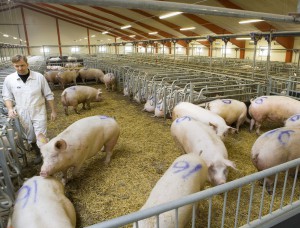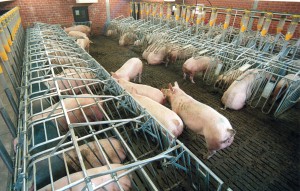One of the major benefits of sow stalls is the ability to feed each sow individually, according to body condition and stage of pregnancy. Group housing systems have varying capabilities for individual feeding and this factor needs to be considered when choosing which method to use. Perhaps the simplest approach to controlling feed intake and protecting sows from bullying while feeding is to use individual feeding stalls with a locking rear gate. These have been used in traditional straw yard systems in Europe for at least 50 years, typically with a group size of 5-10 sows. The system comprises a bedded lying area providing about 15 ft2/sow, a solid floored scrape-through dunging area and then the feeding stalls. Pen dimensions are primarily determined by the width of the feeding stall, which is usually 20”, so that for a group of six sows the pen width would be 10ft, making the lying area 9ft deep. Overall space requirement relative to other systems is high, at 36 to 40 ft2/ sow, making the capital cost of a building quite high. Also, feeding is usually by hand, making it rather labour intensive. However, the system can be easily constructed using farm labour, which made it very popular in the 1960s and 1970s. Then, as average unit size grew, this labour-intensive method started to be replaced with new methods of more automated group housing.
Cafeteria feeding popular in Denmark
Despite the advent of these new methods, such as electronic sow feeding (ESF) and trickle feeding, many Danish producers have opted for a system adapted from the old sow yards in order to benefit from the simplicity and reliability at the expense of some extra labour input and the relatively high initial cost. They developed the “Cafeteria” system, which has a row of individual feeders that is used by each pen of sows in turn. This design allows sows to be housed in larger groups because the layout is not constrained by the feeder dimensions. It also reduces the cost significantly by utilizing one feeder for up to 8 groups of sows. The building design is simple, with straw bedded yards, usually holding sows bred within a week of each other, a scrape-through dunging area and then the row of feeders. Producers using the system say that it is easy to operate, has no complicated equipment and requires little maintenance.
 The major drawback in some people’s eyes is the higher labour input compared to other methods. Although automatically filled feed dispensers are used, the same amount of feed has to be dispensed to each sow in the group because sows often use a different feeder at each feeding session. Therefore, the operator may have to give additional feed by hand to individual sows according to body condition. Also, because there are multiple groups of sows using the same feeders, the operator must be present over an extended period of time to feed all the sows. If locking rear gates are used, he must unlock the gates to release the sows after feeding, then place the sows back in their pen before letting another group out to feed. The dispensers are filled while one group of sows is feeding, ready for the next group.
The major drawback in some people’s eyes is the higher labour input compared to other methods. Although automatically filled feed dispensers are used, the same amount of feed has to be dispensed to each sow in the group because sows often use a different feeder at each feeding session. Therefore, the operator may have to give additional feed by hand to individual sows according to body condition. Also, because there are multiple groups of sows using the same feeders, the operator must be present over an extended period of time to feed all the sows. If locking rear gates are used, he must unlock the gates to release the sows after feeding, then place the sows back in their pen before letting another group out to feed. The dispensers are filled while one group of sows is feeding, ready for the next group.
Klaxon signals eating time
Another apparent disadvantage of the cafeteria system is the stress caused by making sows wait for feed while they watch other groups go to the trough. However, having watched this system in action, it is clear that sows become conditioned to feeding at a particular time and don’t get excited until very close to the time they are released. This conditioning is quickly developed providing the operator follows a specific routine. At one farm I visited, the operator used a klaxon to signal feeding times for each group – one blast for the first group, two for the second group and so on. It was amazing to watch the reactions of the sows; those that were not due to be fed didn’t respond at all. Certainly, if there is any stress, it isn’t reflected in the performance results, which appear to be similar to other types of sow housing.
Handling of solid manure and straw requires a significant labour input, but hard manual work is avoided by the use of machinery. In addition, using straw adds cost, too. Notwithstanding the list of disadvantages, the system is now widely used in Denmark because of its simplicity and reliability, although much less so in other European countries.
Slatted floors save space
Another method involves combining individual feeding stalls with a slatted exercise and dunging area, a system that has been adopted by producers in Denmark and a number of other countries. Generally termed “free access stalls”, this method saves space by utilizing the feeding stall as a lying area. It requires each sow to have its own stall, which makes the system rather expensive, despite the lower overall space requirement compared to the cafeteria system. The free access stalls must have a mechanism that locks the rear gate when the sow is in the stall but allows her to release it as she backs out, otherwise sows may attempt to enter another sow’s stall at feeding time. Layouts for free access stall systems usually involve two rows of stalls backing onto a common dunging area. Group size may range from 10-30 sows per pen.
 Slatted free access stalls reduce labour requirement dramatically, but have some disadvantages for the sow. First, although free to leave the stall and roam in the dunging area, sows often spend the majority of their time locked in the stall, because there is no bedding to root in. While supporters of sow stalls always suggest this is because the sow feels protected in the stall and is happier there, the real reason is the sterile outside environment with a lack of things to do. The second drawback is the potential for foot and leg injuries in slatted pens, especially after sows are mixed. Very high quality slats with rounded edges can help to minimize this problem, but there is no doubt that injuries are significantly higher than in bedded systems.
Slatted free access stalls reduce labour requirement dramatically, but have some disadvantages for the sow. First, although free to leave the stall and roam in the dunging area, sows often spend the majority of their time locked in the stall, because there is no bedding to root in. While supporters of sow stalls always suggest this is because the sow feels protected in the stall and is happier there, the real reason is the sterile outside environment with a lack of things to do. The second drawback is the potential for foot and leg injuries in slatted pens, especially after sows are mixed. Very high quality slats with rounded edges can help to minimize this problem, but there is no doubt that injuries are significantly higher than in bedded systems.
Both dry feed and liquid feed can be used in free access stalls, usually dispensed automatically. Where dry feed is given, sow body condition can be controlled by adding additional feed by hand, but this is not possible with wet feeding. Alternatively, sows can be grouped by condition at the time of mixing and the feed level adjusted for the group as a whole.
Other aspects of management vary between the cafeteria system and free access stalls. In the latter system, where sows spend a lot of their time in the stalls, jobs such as scanning and vaccination are easier. Because each sow has its own stall, they can be locked in at feeding time and the particular task carried out when convenient. In a cafeteria system, where several groups use each set of feeding stalls, the tasks have to be carried out on sows while they are in the lying area, which is less easy.
Conclusions
These two systems using individual feeding stalls offer very straightforward options for housing groups of sows that are easy to understand by producers and have a low maintenance requirement. Those with a phobia about electronics are especially drawn to them! The systems can be built with either solid or bedded floors and can accommodate a range of group sizes, with about 40 being the practical maximum in most cases. They are especially suitable for small-to medium sized units, typically up to 1000 sows. Their primary disadvantages compared to other alternatives are the higher labour input and relatively high capital cost.
Photo captions:
- Danish Free access stalls-1 – A bedded free access stall system in Denmark
- Chore-Time_GestationStall.jpg – A slatted free access stall system (photo courtesy Chore Time)









